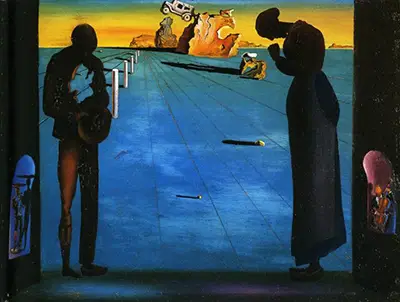This composition stretches the two figures to cover most of the vertical length of the canvas and they are placed closest to us. They are perhaps standing by a doorway, with Dali then capturing the main composition within a dark frame which is constructed from these same architectural elements. It is difficult to determine too much because this part of the artwork is saturated with dark tones. We then find a long passage of blue tiles which lead all the way to the back of the painting, where at the back we find a bright yellow landscape with several surrealist elements within that. Most of the composition is sparse, forcing our attention onto the two figures in front of us.
Millet's Angelus captures a farming couple during evening prayers. Dali took this iconic image from the French Barbizon School and placed it within his own strange, surrealist world for which his career is now best known. He frequently revisited art from the past as inspiration for his own work, normally adding a twist of innovation to modernise the original piece. He is known to have studied many Spanish artists from previous centuries, such as Goya and Zurbaran. Within his overall career he was much more than simply a Surrealist painter - there were early impressionist paintings and also some expressionist art as well, plus also his explorations into other disciplines such as sculpture, drawing and furniture.
The lives of peasants or the working poor has generally been ignored by the majority of famous artists but Dali incorporates farm workers here in direct respect for the work of Millet who was an artist that concentrated on people from these types of backgrounds. Some found a beauty in these relatively simple lives and were not as drawn to the rich and famous as others. Dali himself was a moralistic individual who did see problems in society that needed to be resolved and whilst his lifestyle was incredibly extravagant, he still displayed a connection to the poorer parts of society from time to time.

